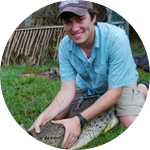About This Project
Aquatic insects begin life as larvae in the water, growing and gathering resources before they emerge as adults on land to reproduce. This transition between water and land links the two habitats, as the adult insects become food for bats, birds, and reptiles. When aquatic habitats are stressed, as by contaminants, this link can be broken by way of reduced insect emergence to land. Our goal is to find out what happens to these insects when agricultural contaminants get into the water.
Ask the Scientists
Join The DiscussionWhat is the context of this research?
Pesticides, fertilizers, and metals have become synonymous with modern agriculture in the last several decades. Today, these chemicals are widely used and often introduced to freshwater systems like lakes, rivers, and wetlands following soil disturbance and rainfall. In the water, such contaminants can disrupt aquatic ecosystems by altering resources or reducing survival of insects, fish, and amphibians through direct toxicity. Aquatic insects are important both in water and on land as food for other animals. When insects are impacted by chemical stress or become contaminated through exposure, the animals that depend on them, like fish, bats, and waterfowl suffer too. Understanding these far-reaching environmental effects can help to better manage agricultural development.
What is the significance of this project?
Recent research has made great strides in increasing our understanding of these impacts, but more data is needed to grasp the full extent to which agricultural contaminants influence aquatic systems. This project adds to the existing body of research in important ways, by studying community-level impacts of two common agricultural contaminants in an environmentally relevant way. Many studies of contaminants look just at one chemical in a laboratory environment using just a handful of organisms, but this project takes a controlled outdoor approach. We will be introducing known levels of contaminants as in lab experiment, but use a naturally colonizing mix of insects, who are exposed to changing weather and community interactions, not just an ideal living situation.
What are the goals of the project?
We want to know what happens to larval and adult aquatic insects and their surrounding ecosystem when atrazine and selenium are introduced to waterways in low levels. The goal is to understand the effects of these contaminants that are already being introduced to wetlands, lakes, and rivers across the country. Using an outdoor tank set-up for this experiment, we have the benefits of replication, control over contaminant levels, and the ability to know a lot about our small system. However, retaining realistic conditions will help us to see how these effects could scale up in wetlands and ponds. Funding will help reach our goals to have chemical analyses and lab work completed by January 2017, with final results by spring 2017.
Budget
Data and water samples from this project have been collected, and what remains to be completed is some insect identification, biomass measurements, and chemical analyses. Funding an undergraduate researcher would both help to complete the remaining work for the project, and be an investment in future research by giving that student valuable experience to help further his or her career.
Chemical analyses can often be the most expensive part of a contaminant experiment, since they typically require highly skilled staff and specialized instrumentation. External funding in the form of a grant from the South Dakota Game, Fish, and Parks is covering the expense of selenium analyses from the experiment. However, the atrazine testing will be done in house, and requires purchase of test kits, for which there is no other funding budget currently available. These analyses are crucial for confirming the amounts of contaminants introduced to the water in the experiment.
Endorsed by
Meet the Team
Affiliates
Brianna Henry
Upon discovering I'm a biologist (and one that studies insects no less!), the people I meet often say something to the tune of "Glad someone's doing that, but I could never!". To me, though, I have the most exciting job in the world. I get to spend my days thinking about the fantastic complexities of the world around us, and how easily they can be thrown off course by the disturbances we add to that balanced environment. Each day, whether wading around in the mucky wetlands my insects call home, identifying them back in the lab, or even analyzing data and water samples, I get closer and closer to the answers to the questions we ask- and then we come up with some more.
I've been working on research projects (first with amphibians, then with crayfish, and now aquatic insects) since my freshman year as a biology major at Clarion University in Pennsylvania. When I graduated is 2015, I left my east coast home to join the biology department at the University of South Dakota, where I could study agricultural influences on aquatic systems where these issues are most prevalent. I was awarded a National Science Foundation Graduate Research Fellowship to sponsor me through my studies at USD, on the basis of the research I'm currently working on.
I'm in the second year of my master's degree, and plan to continue asking questions about how the environment changes with humans in it for a long time. Once I graduate, I hope to take a state or federal job doing aquatic research for a year or two before going on to get my PhD.
Additional Information
This project is a chapter for my master's thesis at the University of South Dakota, and pairs carefully with a larger field project that looks at insects, fish, and amphibians in agriculturally influenced prairie pothole wetlands in eastern SD. We recently got some press on the larger project, which you can read more about and see a short video about here!
Project Backers
- 7Backers
- 8%Funded
- $146Total Donations
- $20.86Average Donation




